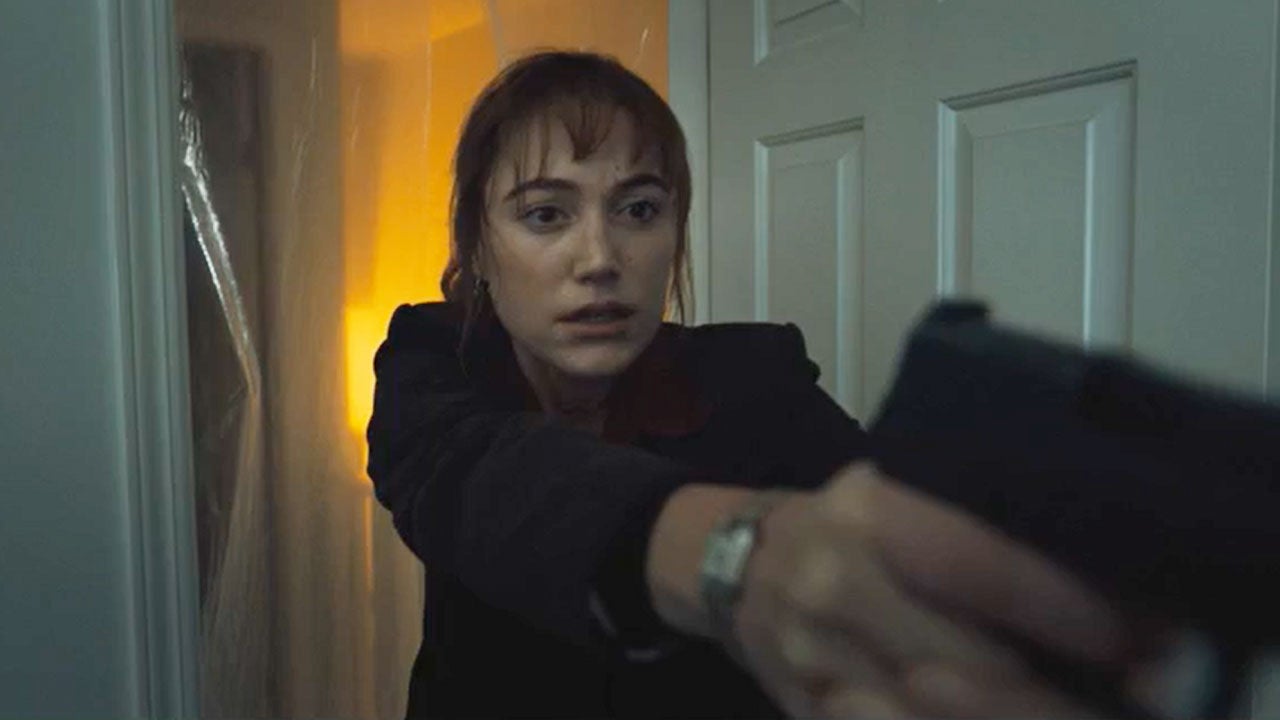Warning: Some spoilers follow for Longlegs.
If you’re a fan of horror movies, there’s a fair chance you’ve heard about writer-director Osgood Perkins’ latest nightmare, Longlegs. The terrifying siren song of the film’s impeccable marketing strategy teases dark imagery and cryptic ciphers around every corner. Oh, and a horrifying performance from Nicolas Cage as the film’s central villain waiting in the wings, hidden until opening weekend—can’t forget about that crucial detail.
But for all the hype Longlegs has garnered in horror circles since Neon dropped the first teaser back in January, the film is intrinsically anchored to its origin story of suburban normalcy. Longlegs follows a hardened FBI agent (Maika Monroe) who is tasked with uncovering the mystery of why a string of fathers killed their entire families—but the core of the real villain, played by Cage, goes deeper. According to Perkins, the seeds of the messed-up central character were birthed from his own personal experiences as a father.
“It was having the idea for the character of Longlegs, knowing what he felt like, what he was about, how he operated,” Perkins tells IGN. “This idea that there was a kind of shabby birthday clown, birthday performer type. As a parent, I've seen a lot of these people come and go through my life, [at] my kids' birthdays. Every once in a while, you get the person who comes and they've got a bad run in their stocking and it's very sad, and it's very strange and unsettling for me when you see something like that where a hole has been punctured in the presentation to a child. The idea of this guy that came to your house on your kid's birthday and interacted with your kid when you weren't really looking and was performing a little bit or had a song to sing or had something to bring, a gift to give. All of these things were in this orbit around this entity, this character.”
Coming off genre films like The Blackcoat's Daughter (2015) and I Am the Pretty Thing That Lives in the House (2016), Perkins was ready to make a film that was more accessible to a wider audience—and what better way to get an audience to take the ride with you than using The Silence of the Lambs as your shining North Star? Perkins calls the “totally perfect” 1991 classic “the invitation to a world that would feel familiar and nostalgic and safe in its weird way.” The filmmaker wanted to use the Silence of the Lambs feel of Longlegs as “bait to lull” the audience in.
“The Silence of the Lambs stuff, it's like your admission ticket,” he says. “It gets you through the door. It's like a vampire. Once a vampire crosses the threshold, then anything's fair game at that point. You invited the vampire and you f—ked up. Now, the vampire is going to do what they want. Once you're inside and you can go in these different directions, it's liberating and it's freeing and it's fun and you can always refer back to, ‘Oh, but don't forget it's a police procedural.’”
For the filmmaker, it was all about putting the supernatural inside a container of realism. Perkins adds a whole extra layer to the conventional procedural tropes by inviting the audience into a serial killer story where the outlandish and improbable beliefs of the perpetrators turn out to be a tangible and terrifying link to the darkness behind the murders that occur. “Knowing Longlegs [was going to be] the monster behind all of that, and just wanting to combine the serial killer procedural with a supernatural, unknowable universe was how it [started],” he explains.
One of the most crucial choices Perkins made that allows for both the supernatural and procedural elements to flourish was the music. When it comes to the soundtrack, the film centers on ’70s glam rock band T. Rex, which also plays a key part in the lore of Longlegs himself. In fact, Perkins even chose to open the film with an epigraph of choice lyrics from the band’s 1971 hit “Bang a Gong.”
“For me, music is where everything comes from or everything passes through. If there's the Great Source, the muses or whatever you want to call that, God, I don't know what terminology people want. But for me, all of that messaging passes through music first,” Perkins says. “Everything that I do starts with it, sounds like something, or it feels like a lyric or it has some kind of vibe to it, a certain warmth to it or a coldness or a rhythm or a cadence. You start to feel all that stuff. With T. Rex, [they were] not something that I really knew very much about and [they] just came into my world at a certain time when I was breaking the story. It was just the soundtrack that life gave me. I didn't seek it out. It just sort of happened.”
Naturally, having this kind of happy accident occur when you’re trying to spread your wings on your latest idea is every creative’s dream. “When you're in my job, you have to make everything up. You have to look for help,” he continues. “Things start to develop in ways you didn't expect—because to pretend like I'm in command or I'm in control of the story is a bit whack to me and it's a bit backwards. I'm there trying to figure out what it is. It already knows what it is. I'm just trying to coax it out of its hole. If the universe says, ‘Hey, it's probably T. Rex,’ my job at that point is to say, ‘I suppose it's T. Rex.’”
Aside from the gut feeling he had about including the rock ‘n’ roll legends, the lyrics ended up truly sealing the deal with nods to the “teeth of the Hydra,” a many-headed monster that in the metaphorical sense bears an interesting resemblance to the film’s namesake antagonist and his mysterious motives. The villain’s plan is multifaceted and full of thoughtful, plotted nuances, becoming something of a mass of dangerous heads to vanquish by the time Maika Monroe’s FBI agent lead Lee Harker realizes the depth of Longlegs’ sinister scheme.
Monroe’s process for getting into the headspace of Harker included another badass female character she found a connection to. “A big influence actually was Rooney Mara and [Girl With the] Dragon Tattoo,” the It Follows actress explains. “I just saw a lot of similarities between the two of them and how they go through life and things that they're uncomfortable with, [like] conversing with people. Where they feel comfortable is solving a case and looking at horrific photographs. That's where they come to life, so that's where it began.”
Monroe adds that, not unlike Silence of the Lambs’ Clarice Starling, an important part about Harker is her childhood and childhood trauma. The detective’s history with this case goes deeper than she realizes, so far back that she has blocked it all out in an act of preservation. “[It’s about] all the things that have been suppressed and pushed down,” she says. “What you keep hidden and what has been hidden from the audience and where you could bring little things forward, little clues and whatnot. It was a very fun role.”
Monroe grew up on procedural thrillers like Silence of the Lambs, Seven, and Memento, so being part of a project like Longlegs felt like a natural step—but nothing could’ve prepared her for what it would be like to work on a film in that genre with none other than Nicolas Cage.
When asked about the most memorable moments with Cage on set, it’s no surprise that both Perkins and Monroe tip their hats to the chilling interrogation room scene where we first see Harker and Longlegs meet face to face. “Before Maika came in that day, we had Nick doing his intake interview, which you see in the movie when he sings ‘Happy Birthday’ to Lee,” recalls Perkins, touching on an utterly chilling moment where we see the evil that lives within Longlegs. “That was me and the DP and the assistant director in this little room with Nicolas Cage and a VHS camera and just doing one take of this long interview that he does, and we sat there for an about 25- or so minute take where he did all the dialogue. We were all just in this captivated, petrified—not in a scared way—but just still [in a] frozen state of ‘This is really happening, really in this room. That's really Nicolas Cage. Did you know that he's in this movie?’ It's a really good time. It's what you want to be doing if you're us.”
Cage’s legacy looms large, a concept Perkins is intimately familiar with. His father is Psycho star Anthony Perkins, an icon of the horror genre whose performance in the 1960 Alfred Hitchcock classic has gone down in infamy. But the Longlegs mastermind doesn’t find himself all that concerned with living up to the storied reputation left behind by his late parent.
“The really good news is that I don't wake up and stand in front of the mirror and say, ‘How are you going to do it today? How are you going to live up to it today? You're going to be good enough.’ I think that when you're younger, that internal dialogue plays a lot louder, and then you get older and you realize that nothing really f—king matters,” Perkins laughs. “So you're going to be fine. I think that what resonates for me with my dad especially—because there's certainly my dad of Psycho, but that's 15 years before I'm born. It doesn't really have anything to do with me. It's him, but it's him that I never knew. But also… my kid looks the same and walks the same. There's a bunch of weird stuff that kind of goes on with that.”
He adds, “But much more prescient in my experience was something like him directing Psycho III and the fact that he brought such a strong take to that movie. There's a real dirtiness to Psycho III. There's a really kind of red light district perversion to Psycho III that really isn't in the previous two pictures. Psycho, the original, is very perverse for its time, obviously was considered quite perverse. But seeing my dad's palette and wry sense of humor in the third movie is something that I think about maybe more than anything. The performance in Psycho is a museum piece in the best possible sense of the words, so it's a bit untouchable. But what he chose to do, how he chose to make Psycho III this weirdly lewd thing was like a fun gesture that I bet you Universal probably was like, ’Oh. This is really what we're doing?’”
With Longlegs, Perkins is proving himself as a contender to be just as valuable to the horror genre as his father once was. And that’s defintiely a worthwhile legacy.






